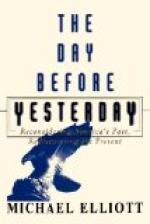This is no place to speak of the marvels of Mogul architecture in Agra and Delhi. I do not believe that there exists in the world a more exquisitely beautiful hall than the Diwan-i-Khas in Delhi palace. This hall, open on one side to a garden, is entirely built of transparent white marble inlaid with precious stones, and with its intricate gilded ceilings, and wonderful pierced-marble screens it justifies the famous Persian inscription that runs round it:
“If heaven can be on
the face of the earth,
It is this, it is this, it
is this.”
I always regret that Shah Jehan did not carry out his original intention of erecting a second Taj of black marble for himself at Agra, opposite the wonderful tomb he built for his beloved Muntaz-i-Mahal; probably the money ran out. Few people take in that the dome of the Taj, that great airy white soap-bubble, is actually higher than the dome of St. Paul’s. The play of fancy and invention of Shah Jehan’s architects seems inexhaustible. All the exquisite white marble pavilions of Agra palace differ absolutely both in design and decoration, and Akbar’s massive red sandstone buildings make the most perfect foil to them that could be conceived.
Lucknow is one of the pleasantest stations in India, with its ring of encircling parks, and the broad, tree-shaded roads of its cantonments, but the pretentious monuments with which the city is studded will not bear examination after the wonders of Agra and Delhi. The King of Oude wished to surpass the Mogul Emperors by the magnificence of his buildings, but he wished, too, to do it on the cheap. So in Lucknow stucco, with very debased details, replaces the stately red sandstone and marble of the older cities.
In 1890 after a long day’s sight-seeing in Lucknow, in the course of which we ascended the long exterior flight of steps of the great Imambarah on an elephant (who proved himself as nimble as a German waiter in going upstairs), Lady Lansdowne and I were taken to the Husainabad just as the short-lived Indian twilight was falling. On passing through its great gateway I thought that I had never in my life seen anything so beautiful. At the end of a long white marble-paved court, a stately black-and-white marble tomb with a gilded dome rose from a flight of steps. Down the centre of the court ran a long pool of clear water, surrounded by a gilded railing. On either side of the court stood great clumps of flowering shrubs, also enclosed in gilded railings. At the far end, a group of palms were outlined in jet black against that vivid lemon-coloured afterglow only seen in hot countries; peacocks, perched on the walls of the court, stood out duskily purple against the glowing expanse of saffron sky, and the sleeping waters of the long pool reflected the golden glory of the flaming vault above them.
In the hush of the evening, and the half-light, the scene was lovely beyond description, and for eighteen years I treasured in my mind the memory of the Husainabad at sunset as the vision of my life.




